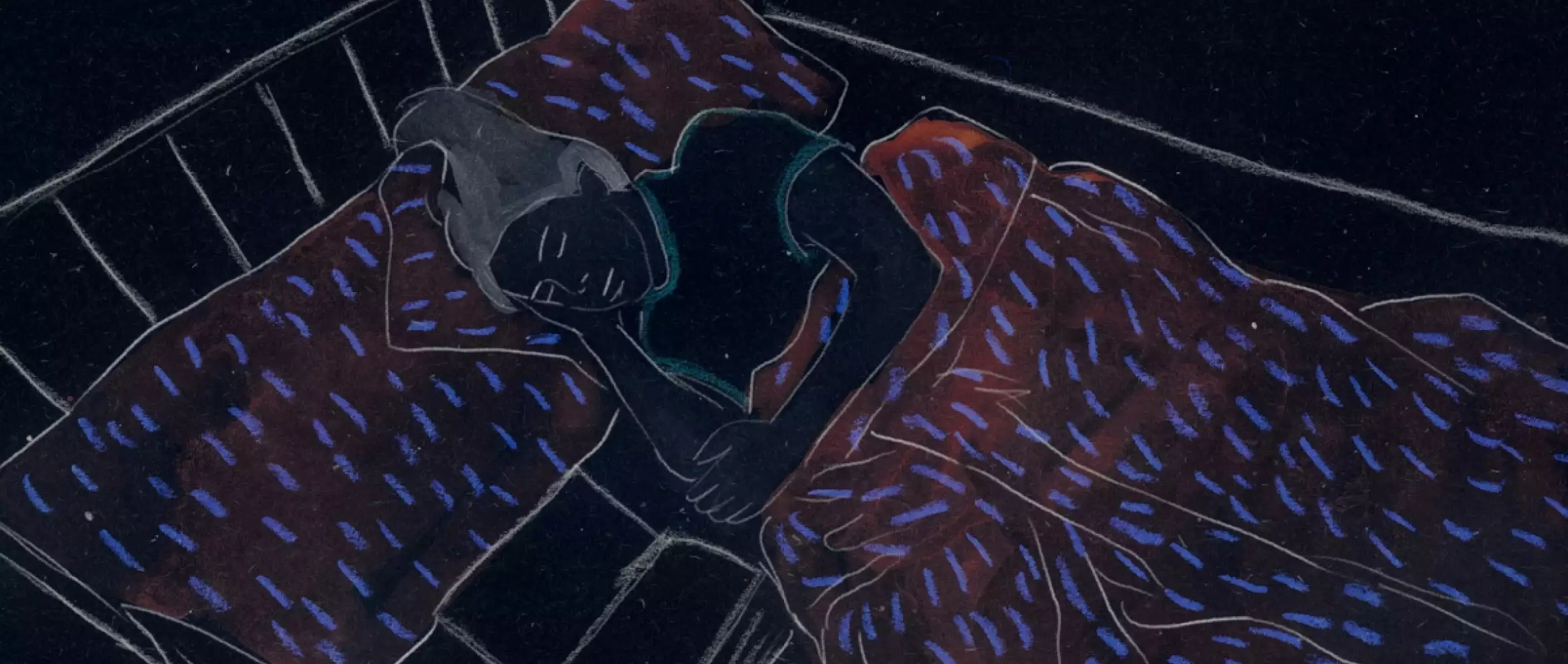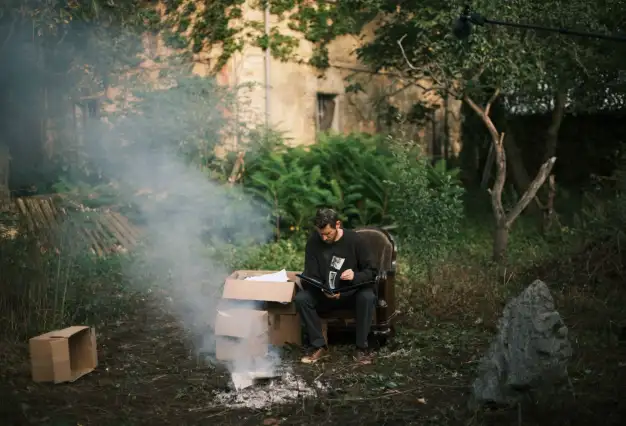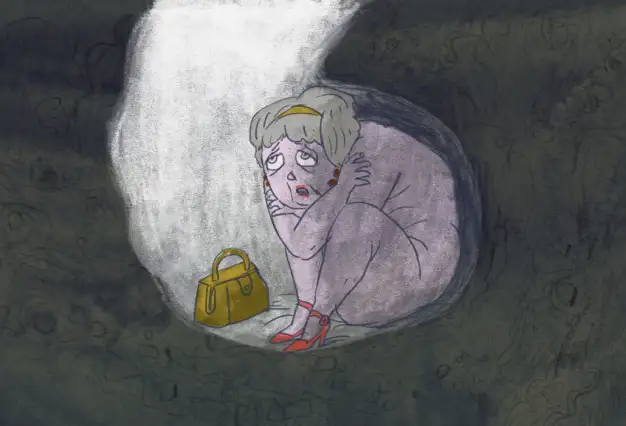
28 January 2021
Czech short films destroy the creative boundaries
Czech short films destroy the creative boundaries

Domestic short films are bending the borders of form, genre, and the medium itself. Beyond the successful showing of mostly animated shorts on the international festival circuit recently, much more has been going on in what is currently the most vibrant and diverse sector of Czech AV production.
Article by Martin Kudláč for CZECH FILM magazine / Spring 2021
From urgent topics in society to abstract experimental visual works, Czech short films encompass the full spectrum. With a multiplicity of forms, techniques, and approaches, short film is the most vibrant and vital feature on the audiovisual landscape. Genre-crossing, convention-bending, and boundary-blurring, the energy of artistic freedom is producing an intriguing variety of cinematic stories as well as conceptual works for big and small screens, site-specific spaces, and art galleries.
Many Czech filmmakers have at least one short film under their belt, be they young directors like Jan Těšitel and Robert Hloz, or those with established careers, like Jitka Rudolfová, Pavel Göbl, Petr Marek, and Marek Najbrt. Even household names with international reputations, like Bohdan Sláma, Václav Kadrnka, and Petr Vaclav, have made short works at some point in their careers. While short narrative works still tend to be regarded as a rite of passage in the ascent to a career of feature-filmmaking, the recent crop of short films in the Czech Republic proves the format has succeeded in carving out an autonomy of its own.
The legacy of animation lives on
Lately, the international spotlight has been pointed at Czech animation, which has an especially strong pedigree in Czech cinema, thanks to world-renowned masters of the craft like visual illusionist Karel Zeman (1910–1989), prolific artist Jiří Trnka (1912–1969), multitalented and pioneering animator Břetislav Pojar (1923–2012), and the surrealist maestro Jan Švankmajer. Czech animation, especially in the short format, continues to evolve and innovate.
The buzziest animated work on the international circuit to come from the Czech Republic is Daughter (2019), by the up-and-coming Daria Kashcheeva. A stop-motion puppet drama, Daughter combines documentary-style filmmaking, inspired partly by Dogme 95, with techniques from painting, in particular expressionism. After garnering the Student Academy Award, Kashcheeva’s short landed an Academy Award nomination for Best Animated Short Film. Meanwhile, Michaela Mihályi and Dávid Štumpf’s 2D hand-drawn Sh_t Happens (2019), a colorful fable-like tongue-in-cheek cross-over between the story of Noah’s Ark and the Titanic, with an interspecies relationship crisis at its core, got off to a great start, premiering in the Orrizonti Short Competition in Venice. Following Daughter’s lead, Sh_t Happens also qualified for the 2021 Oscar nominations, and as a Czech-Slovak-French coproduction, it is one of 12 short animated films nominated for the César Awards (the French Oscars).

Documentary crossings and nonfiction hybrids
The domestic animation scene is especially ripe with fairy-tale shorts for the youngest moviegoers, like Alexandra Májová and Kateřina Karhánková’s Blueberry Hunt! (2017) and Karhánková’s award-winning solo film, Fruits of Clouds (2017). However, one genre of animated shorts in particular has been gaining steam recently: anidocs, that is, animated documentaries, a creative hybrid used to present social or psychological issues with intriguing aesthetics and artistic styles, in defiance of the formalistic conventions of documentary filmmaking.
Vietnamese-born illustrator and filmmaker Diana Cam Van Nguyen is one of the creators who experiment with nonfiction animation to deal with personal topics. Her autobiographical bachelor’s work The Little One (2017) maps her childhood growing up in the Czech Republic, while her short portmanteau film Apart (2018) combines expressive styles to give a visual narrative structure to young people’s experiences of loss and grief. Apart netted the Best Czech Experimental Documentary Film at Ji.hlava IDFF. Another filmmaker following the same path is Nora Štrbová, who in S p a c e s (2020) employs animation to depict her brother’s life with a brain tumor and the way it distorts his memory and identity.
Other creators have used animation to explore social themes. FAMU student Adela Križovenská looks at the fallout of institutionalization on children growing up in Czechoslovakia in Forget Me Not (2019), which superimposes testimonial voiceovers on metaphoric and symbolic visuals. Michaela Režová examines the history of Czechoslovak ice hockey in Chase (2017), reliving both its glory and its dark moments, including the imprisonment of players in 1950, mapping transformations in society, politics, and culture. Režová employs the testimony of players who suffered persecution under the Communist regime, as well as archival footage and a collage of period animated sequences and graphics.
At the same time, live-action documaking is still holding its own in the short-film format, though its traditionally formalistic horizons are expanding. In The Last Shift of Thomas Hisem (2017), young director and producer Jindřich Andrš captures the last shift of a miner before his workplace closes for good, mounting a camera on the protagonist’s head to capture his perspective as he performs his last tasks. The short led to Andrš’s award-winning feature-length documentary debut, A New Shift (2020), a sequel in which he follows Hisem in his journey toward a new career as an IT specialist. While Andrš is one of a circle of journalistic documentary makers, some of his colleagues have developed less-conventional nonfiction filmmaking styles with an experimental bent.
Viola Ježková goes beyond the surface of descriptive depiction in her poetic, autobiographical works Body of My Body (2012) and Everything Has Its Own Time (2017), which (re)create a mental space through introspective imagery that acts to transcend the personal. Body of My Body touches on not only breastfeeding but more universal subjects, while Everything Has Its Own Time explores memory and consciousness. Composed as a travelogue, On the Edge (2018) captures the mindset of Czech flat-earthers, brought to light by Barbora Chalupová, the rising filmmaker who codirected the biggest-grossing Czech documentary in recent history, Caught in the Net (2020). In a similar vein, Květa Přibylová embraces the abstract dispositions of image and sound in her 16mm film cum poetic essay, Traces, Fragments, Roots (2016), which revolves around the relationship of humans to nature.
Artist Adéla Babanová is in a league of her own, with a body of work straddling the media of moving image, film, and video installation. In her loose trilogy of cinematic docufiction and mockumentary shorts — Neptune (2019), Where Did the Stewardess Fall From? (2014), and Return to Adriaport (2013) — she focuses on events from recent history, infusing them with a mystifying, even surreal vibe. Her idiosyncratic visions result from the combination of authentic found footage and staged scenes, producing a sort of “historic phantasmagoria,” where facts dissolve into fiction and vice versa.

The collision of formalistically inventive works with stories of Haneke-like horror
In light of such outstanding and boundary-pushing shorts, the more prevalent craft of live-action fiction filmmaking may be deemed uninspired. Yet nothing could be further from the truth. Two significant strands have crystallized within this vein of Czech short film production recently. One is represented by such formalistically inventive and genre-bending works as Marie Dvořáková’s surreal and playful grotesque Who’s Who in Mycology (2016), a film about living fungi encyclopedias that shares the whimsicality of Jan Švankmajer’s early works. Dvořáková’s short film netted the Czech Republic’s first Student Oscar since Jan Svěrák won the honor with Oil Gobblers (1988). Along the same lines, albeit more sinister and mysterious, is Jan Vejnar’s strange grotesque Figurant (2019). Originally programmed for SXSW 2020, Figurant is a modern Twilight Zone-like story on the themes of personal identity and manipulative systems, with venerable French actor Denis Lavant in the leading role.
Another bright example of this inventive approach to live-action fiction filmmaking is Peacock (2015), by Ondřej Hudeček, the first ever Czech film to appear at Sundance Film Festival, garnering the Short Film Special Jury Award for Best Direction. Although technically a biopic of Czech theater legend Ladislav Stroupežnický (1850–92), Peacock is idiosyncratically staged and stylized as a period queer romance, with black humor, bright colors, and blazing self-irony. Another short biopic of a national figure comes from young talent Natálie Císařovská. Although Francek (2020) adheres to a more formal depiction of the early life and career of abstract art pioneer František Kupka (1871–1957), compared to Hudeček’s eccentric treatment of Stroupežnický, Císařovská gravitates toward magic realism in the scenes where the budding artist meets his muse.
The second prominent thread within live-action Czech shorts veers into the murkier waters of realist drama à la Michael Haneke. Rising Slovenian director Lun Sevnik’s microdrama Playing (2019) is about two 16-year-olds who announce they’re going to livestream their suicides. Reconstruction (2018), by directorial tandem Jiří Havlíček and Ondřej Novák, with its more distanced approach to a fatal event, takes the form of a retrospective police reconstruction, employing cruel humor along the way. Anatomy of a Czech Afternoon (2020), an innocent-sounding title by Adam Martinec, is based on the true event of the drowning of two boys. Martinec builds the tension surrounding their disappearance, while also capturing the so-called bystander effect. The visitors near the lake enjoy their sunny leisure as the near-hysterical mother begs them to help her find her offspring. The director leads the careful and calculated setup from banal and mundane to a gut punch of a finale. In Don’t Be a Pussy (2019), the director Jakub Jirásek adopts a less bleak and dramatic style than his peers as he tells the story of two kids who shock a school out of its wits, becoming “the youngest terrorists in the Czech Republic” in their attempt to gain followers on social media.
Czech shorts aren’t lacking for genre either, as in Jan Haluza’s homage to legendary directors Oldřich Lipský and Václav Vorlíček, as well as to Hollywood action movies, in First Action Hero (2019). Pavel Soukup veers to the darker corners of local folklore in Leshy (2015), a fairy-tale horror alluding to Guillermo del Toro’s remarkable fantasy Pan’s Labyrinth (2006), and Soukup’s work in the short format recently received one of the highest acknowledgments possible: The web series #martyisdead (2019), which he directed, became the first Czech short series to win an International Emmy Award.
It also needs to be said that Sevnik, Kashcheeva, and Nguyen are not the only foreigners making short works in the Czech Republic. Priit Põhjala, Anna Lyubynetska, Haukur Hallsson, Ivana Pauerová Miloševič, György Kristóf, and Fiona Ziegler all filmed their shorts in the Czech Republic, and some have gone on to continue their careers in the country. Among those who still work on Czech turf are the Chinese director Piaoyu Xie and the Polish filmmaker Tomasz Wiński. Xie’s short coming-of-age, coming-out drama Nettle (2017) premiered at BFI Flare, and she is currently preparing her feature debut, The Ugly Mandarine (2023), a multicultural same-sex love story. The all-female cast of The Ugly Mandarine is part of the project’s larger aim, with women filling all the roles in the film crew as well. Wiński meanwhile is at work on his feature-length debut, Images of Love (2022). His previous short film, the apartment drama George the Dog, Refugee (2019), explores human nature through two female protagonists who hire a masochistic man pretending to be a dog. The (mis)treatment the man-dog endures at the home of his temporary owners reveals more about the girls’ oppressive tendencies than about the man’s peculiar penchant.

The art of experiment
If any kind of boundaries existed in the past, they have been wiped out by the experimental and conceptual short audiovisual works emerging from the Czech Republic in recent years. Filmmakers and artists have reinvented the moving image in the most creative ways, freed from the constraints of conventional narration and cinematography. In the ’70s, photographer Jan Ságl documented the Czechoslovak underground, and made several auteur art films echoing the experimental trends of the period. Visual artist Zbyněk Balandrán combines different media and means of expression in his short works Dead Reckoning (2014) and The Microscope and Telescope of Time (2013), which seek to identify problems that plague all of society, including paranoia and psychosis. FAMU dean Andrea Slováková has made several essayistic and experimental documentaries: In Sight (2011), Recovering Industry (2016), and most recently the conceptual experiment Five Hundred Plateaus (2020), inspired by Deleuze and Gauattari’s influential book of the same name. Petr Šprincl, who came to filmmaking through installation and performance art, is behind a series of more narrative-inclined yet no less bizarre mid length films: Moravia, O Fair Land, parts I., II. and III. (2016, 2017 and 2019 respectively), a DIY-style camp-thrash experimental western-horror docufiction epic cycle about “Satanism and Moravian nationalism.”
The largest Central and Eastern European documentary film festival, Ji.hlava International Documentary Film Festival, has systematically scouted the Czech art scene, curating intriguing short experimental works, and the festival continues to introduce new generations of filmmakers and artists propelled by their short-form visual art. The diverse class of 2020 includes the space-bending and contemplative After the Magician (2020), by artist Lea Petříková, which ponders the only film ever made by French-Mexican surrealist Alice Rahon, which went missing after she completed it. Visual artist Zbyněk Baladrán’s latest work, Catastrophe (2019), features in the selection as well, referencing the single-act play by Samuel Beckett in a seamless fusion of 10 two-dimensional picture compositions. Also worth mentioning is Martina Kostelanská’s surreal two-minute film Muladhara (2020), depicting a journey from birth to departure to the next reincarnation, through carefully choreographed hypnotic figures.
With current shifts in the audiovisual industry enabling new forms of immersive and interactive narration, short films have become the ideal format for Czech filmmakers to explore emerging technologies. Directors Filip Veselý and Martin Živocký are preparing the short 3D animation 3 - 2 - 1 Start! (2021) in a full-dome format for planetariums, while producer Peter Badač is developing the VR project Letter from the Heart, a prequel to the 3D family animation feature Heart of a Tower (2021), directed by Peter Budinský. Letter from the Heart and the upcoming videogame spinoff of Heart of a Tower foreshadow the rise of transmedia storytelling in local production, which is soon expected to be the norm.

The boom in shorts expands
The ecosystem of short works in the Czech Republic is evolving and expanding at an incredibly rapid rate, with new offerings always on the horizon. Prokop Wilhelm will soon be contributing his animated short Dagon (2021) to a resurgence of works inspired by the notorious cosmic horror author H. P. Lovecraft, and artist Jan Cechl is writing the story for a puppet animation of “the Moravian Lawrence of Arabia,” Alois Musil, in a Czech-Portugal coproduction, Lawrence of Moravia (2021). Diana Cam Van Nguyen continues to explore autobiographical topics, namely the relationship with her father, in her upcoming anidoc Love, Dad (2021). Animator Martin Živocký’s auteur project Colours (2022) will be a metaphorical animated short about the human psyche, and finally, in a follow-up to his successful animated black comedy short Happy End (2015), Jan Saska is now at work on Hurikan (2022), a 2D hand-drawn short about “a deep fried romance from Prague” with a pig-headed alcoholic in the lead.
These short films are just the tip of a thriving short-film production iceberg, from amateur to semipro to professional to artistic. The short format offers ideal conditions as a laboratory of motion picture-making, where new challenges can be met, and radical artistic techniques and aesthetic approaches can be tried out. The daring, thought-provoking, and critically acclaimed short works overflowing from the Czech Republic now offer a thrilling glimpse of what we can expect in the upcoming decade above and beyond the frame of short films alone.




